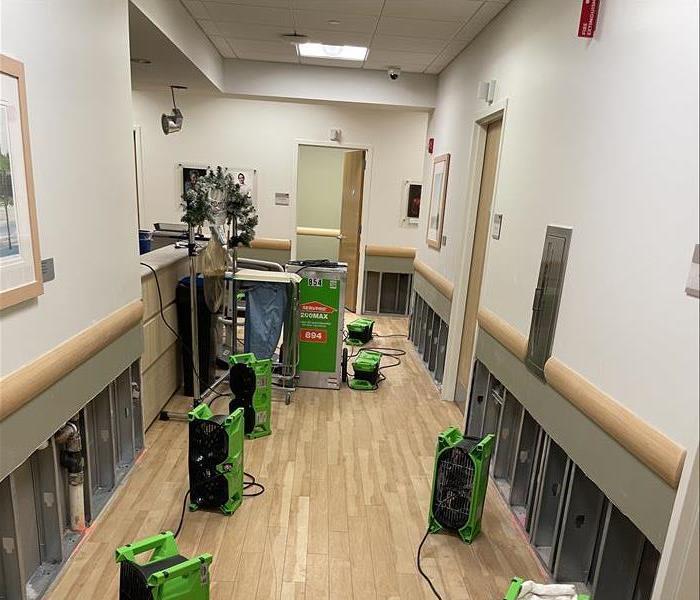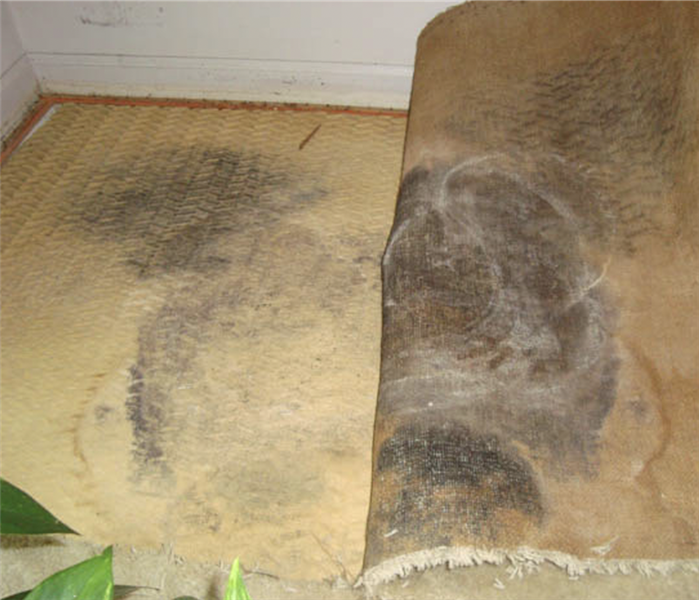Improving Indoor Air: The Dehumidification Process Explained
3/13/2024 (Permalink)
 Understanding the science of dehumidification is important to maintain a healthier indoor environment.
Understanding the science of dehumidification is important to maintain a healthier indoor environment.
Excess humidity in indoor spaces not only creates discomfort but can also lead to a variety of problems, including mold growth, structural damage, and compromised indoor air quality. Understanding the science of dehumidification is crucial for mitigating these issues and creating a healthier living or working environment.
The Role of Relative Humidity
Relative humidity refers to the amount of moisture present in the air compared to the maximum amount the air could hold at the same temperature. It is a key factor in determining indoor comfort and air quality. Ideally, indoor RH levels should be maintained between 30% and 50% to prevent the conditions conducive to mold and dust mites.
Effects of High Humidity
Mold Proliferation:
Mold thrives in damp environments. When humidity levels are high, mold spores can settle and multiply, posing serious health risks to occupants and causing structural damage.
Dust Mites and Allergens:
High humidity provides an ideal breeding ground for dust mites and microscopic creatures that can trigger allergies. Maintaining optimal humidity levels helps control dust mite populations.
Structural Damage:
Excessive moisture can compromise the structural integrity of buildings. It can lead to rot, warping, and decay of wood, as well as corrosion of metal components.
The Dehumidification Process
Dehumidifiers play a pivotal role in controlling indoor humidity levels. These devices utilize a simple yet effective process to extract excess moisture from the air. Dehumidifiers pull in moist air from the environment, guiding it over coils that are colder than the dew point. This causes the moisture in the air to condense into water droplets.
The condensed water is collected in a reservoir or expelled directly through a drainage system. This process leaves the air drier and more comfortable. The now drier air is reheated before being released back into the environment. This ensures that the dehumidification process doesn't compromise the overall temperature of the space.
Benefits of Dehumidification
By maintaining optimal humidity levels, dehumidifiers inhibit the growth of mold, protecting both the structural integrity of buildings and the health of occupants. Reduced humidity levels also contribute to improved indoor air quality by minimizing the proliferation of allergens such as mold spores, dust mites, and bacteria. Dehumidification helps protect valuable possessions, including furniture, artwork, and electronic equipment, from the damaging effects of excess moisture.
Spaces with lower humidity feel more comfortable, even at slightly higher temperatures. This can lead to energy savings as occupants may rely less on air conditioning to achieve comfort. When indoor air is properly dehumidified, HVAC systems operate more efficiently. Dehumidifiers reduce the workload on air conditioners, leading to energy savings.
Choosing the Right Dehumidifier:
When selecting a dehumidifier, consider the size of the space, the severity of humidity issues, and the desired features. Portable units are suitable for smaller areas, while whole-house dehumidifiers integrate with HVAC systems for comprehensive moisture control.
Understanding the science of dehumidification is important to maintain a healthier indoor environment. By controlling relative humidity levels, dehumidifiers not only prevent structural damage and mold growth but also contribute to improved indoor air quality and overall comfort.
Navigating Mold Concerns During Real Estate Deals
10/19/2023 (Permalink)
 Mold can have a significant impact on real estate transactions.
Mold can have a significant impact on real estate transactions.
In today's article, we will shed light on an important topic that concerns both buyers and sellers in real estate transactions – mold. Mold can be a significant concern for property owners, and it is crucial to understand the role of disclosures and inspections when it comes to mold in real estate transactions. Join us as we explore the importance of mold disclosures and inspections, and provide essential tips to ensure a smooth and transparent process.
1. Understanding Mold in Real Estate Transactions
In real estate, mold can present a potential problem for both buyers and sellers. Mold growth can affect the value of a property and may pose serious concerns for its occupants. Therefore, it's essential for all parties involved to have a clear understanding of mold-related disclosures and inspections to protect their interests.
2. Proper Mold Disclosures
Disclosures are crucial in real estate transactions, ensuring that all parties are aware of any known mold issues before completing the purchase. Sellers have a legal obligation to disclose any known mold problems in the property. This includes previous mold remediation efforts, current or past water damage, or any other conditions that may lead to mold growth. Buyers should carefully review the provided disclosures and seek clarification if they have any concerns.
3. The Importance of Mold Inspections
While disclosures provide valuable information, it is also advisable for buyers to conduct thorough mold inspections as part of their due diligence. Mold inspections help identify any hidden mold issues that may not be immediately visible. Hiring a certified mold inspector or registered industrial hygienist will ensure a comprehensive examination of the property, including air sampling and surface testing. This inspection can provide buyers with peace of mind and a clearer understanding of the property's mold condition.
4. Taking Action on Mold Inspection Findings
If the mold inspection reveals the presence of mold, buyers can explore several options depending on the severity of the issue. They may negotiate repairs or remediation with the seller before closing the deal, or request a reduction in price to accommodate the cost of mold remediation after closing. In some cases, buyers may choose to walk away from the transaction if the mold issue is too significant.
5. Seeking Professional Assistance
Navigating the complexities of mold disclosures and inspections in real estate transactions can be overwhelming. Whether you are a buyer or seller, it is always beneficial to seek professional assistance. Engaging the services of a reputable mold remediation company, such as SERVPRO® of Northern Liberties, can provide expert insights and guidance throughout the process. Their expertise will help ensure that all necessary steps are taken to address mold concerns effectively.
Mold can have a significant impact on real estate transactions, potentially affecting the property value. By understanding the importance of mold disclosures and inspections, both buyers and sellers can have a transparent and seamless experience. Remember, when it comes to mold, knowledge is power. Consider consulting with professionals like SERVPRO® of Northern Liberties to navigate mold-related issues and ensure a successful real estate transaction.
Do You Think Your Philadelphia Home or Business Might Have a Potential Mold Problem?
6/9/2016 (Permalink)
 Mold can present itself within 48 hours. If you think you have a mold problem contact SERVPRO of Spring Garden / Fairmont at 215-791-2302
Mold can present itself within 48 hours. If you think you have a mold problem contact SERVPRO of Spring Garden / Fairmont at 215-791-2302
SERVPRO of Spring Garden / Fairmont Specializes In Mold Remediation
Did you know that microscopic mold spores naturally occur almost everywhere, both outdoors and indoors? This makes it impossible to remove all mold from a home or business. Therefore, mold remediation reduces the mold spore count back to its natural or baseline level. Some restoration businesses advertise “mold removal” and even guarantee to remove all mold, which is a fallacy.
Here are some Mold Facts:
- Mold is present almost everywhere, indoors and outdoors.
- Mold spores are microscopic and float along in the air and may enter your home through windows, doors, or AC/heating systems or even hitch a ride indoors on your clothing or a pet.
- Mold spores thrive on moisture. Mold spores can quickly grow into colonies when exposed to water. These colonies may produce allergens and irritants.
- Before mold remediation can begin, any sources of water or moisture must be addressed. Otherwise, the mold may return.
- Mold often produces a strong, musty odor and can lead you to possible mold problem areas.
- Even higher-than-normal indoor humidity can support mold growth. Keep indoor humidity below 45 percent.
If you think your home or business has a mold problem, SERVPRO or Spring Garden can inspect and assess your property and use our specialized training, equipment, and expertise to remediate your mold infestation.
If You See Signs of Mold, Call Us Today – SERVPRO of Spring Garden / Fairmont - Available 24/7 215-791-2302
 Understanding the science of dehumidification is important to maintain a healthier indoor environment.
Understanding the science of dehumidification is important to maintain a healthier indoor environment.

 24/7 Emergency Service
24/7 Emergency Service

